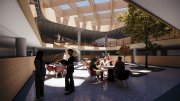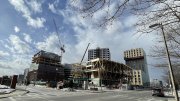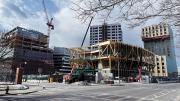Looking toward the University’s four-hundredth anniversary in 2036, the Harvard Library has conducted a feasibility study for the renovations of Widener, Lamont, Pusey, and Houghton libraries. The study, conducted during the 2022-2023 academic year, provides ideas for “possible futures,” said University Librarian Martha Whitehead. She characterized the work as “not final decisions or blueprints, but a guidepost that articulates a vision we can work toward.” Next steps include initiating the process of approval for what will be significant capital projects (and securing funding), and developing more specific design plans for each building. Whitehead’s goal is to complete the renovations by Harvard’s anniversary, which is “only 12 years away,” she said. “Given the scope of all these plans, it could actually span that period.” Widener emerged from a five-year renovation in 2004 with rejuvenated systems and new reading rooms (“Widener Reborn,” November-December 2004, page 61), and Houghton emerged with a newly accessible entrance, refurbished systems, and a redone reading room during the pandemic (“Reopening…Carefully,” November-December 2021, page 13). So why further, significant changes now? The new plans are principally programmatic: they aim to increase student awareness and use of library collections, encourage interdisciplinary scholarship, and offer opportunities for the public to engage more readily with Harvard’s library materials. “It’s hard for students to get a sense of the different types of knowledge that they can access at Harvard, and the faculty are eager to teach across collections and draw on different forms of expertise,” Whitehead said. “We need new intentional spaces to support all this.” Hence, a series of interconnected changes that would relocate and reconceive many of the Harvard Yard libraries and the collections they house.
Widener would be the site of one of the earliest and most visible changes: creation of a publicly accessible “Discovery Center” near the entrance facing Memorial Church. “[Widener] is the heart and soul of the Harvard campus, and people are eager to engage with it,” Whitehead said. “I like to say that Widener Library is a symbol of Harvard. It’s always used as this iconic picture of what Harvard is all about, and it shouldn’t be a closed door to knowledge. There should be some way [for the public] to enter and experience what that element of the University is all about.” Further planning would determine what form that public access might take, such as weekly tours or set hours for visitors.

Nor is public access the only change envisioned. In the longer term, the Harvard Map Collection, “very hidden” in the underground Pusey Library, would move into a space that is now used for circulation on Widener’s first floor. The wall that divides this space from rest of the building would be replaced with a glass exhibition wall, enabling Discovery Center visitors to view highlights of the map collection. Across the hall, Widener’s original “treasure room” could feature exhibits from the Harvard University Archives, also currently in Pusey, and include another glass wall providing a view into the stacks. “We wanted to give people who don’t have access to the stacks a sense of the realm of the stacks,” Whitehead said—a common feature in university libraries such as Yale’s Beinecke. Designers will also explore how to make Widener’s Yard-facing entrance wheelchair accessible, possibly by inserting a recessed entry door into the east side of the stone abutment flanking the Widener steps, which would provide access to an elevator.
The most significant changes proposed affect Lamont, the 24-hour library popular among undergraduates. “There are many things that people love about Lamont,” Whitehead said, “and yet it’s tired, and it needs a lot of love and care.” The feasibility study proposes updating the building’s infrastructure and furnishings while retaining its mid-century modern aesthetic. Lamont’s basement, now a little-used media lab, would become a secure reading room for special collections and archives, which would deliver materials from Houghton, the University Archives, and the Fine Arts Collection. Now, “Houghton materials are used in Houghton; archives materials are used in Pusey,” Whitehead said. “This would bring everything together in a larger space.”
The reenvisioned Lamont would make it possible to return the Fine Arts Library collections to their historic location within what Whitehead called the “fine arts corridor” on Quincy Street: the Harvard Art Museums, the Carpenter Center for the Visual Arts, the Graduate School of Design, and the department of history of art and architecture—now in the Sackler building, on Broadway. (The fine-arts materials, formerly located in Werner Otto Hall, were moved to Littauer Center, far from almost all users, when the building was demolished in 2008 as part of the Art Museums’ renovation, and have never returned from this sort-of exile.) The plan is to intersperse the fine arts materials throughout Lamont’s three floors. To make space for those materials, duplicates of “materials that are not circulating as much,” Whitehead said, will go from Lamont’s shelves into storage. The Woodbury Poetry and Forum Rooms will also be reimagined, and a printing press—currently in the basement of Lamont—will be moved to the front of the building to make a “book arts studio.”
Pusey renovations will aim to expand how patrons use collections. With the archives reading room and the map collection relocated, there would be space to create “a modern hub,” Whitehead said, where physical and digital research methods can interact. A “Digital Research Commons,” suitably equipped, would replace the archives reading room. The library would be reconfigured to admit more natural light, and the main entrance would be made wheelchair accessible.
The feasibility study also proposes further renovation of Houghton, with its rare-book holdings. “It’s a beautiful renovation,” Whitehead said of the work completed in 2021, “but one of the key things we hear as a need is just more opportunity to interact with those special collections, for small classes to work with them.” Its secure reading room will be relocated to the Lamont space. Houghton’s vacated reading room would then become an events space with furniture that could be arranged to accommodate conferences, classes, and lectures. Connections between Pusey and Houghton will be improved to better integrate staff and provide access to shared amenities.
The renovations, if approved, will be conducted in four phases. The first would focus on Lamont—prioritized because of its aged infrastructure, importance to undergraduates, and repurposing of space to accommodate other functions and collections to be moved—and the development of Widener’s Discovery Center. A second phase would integrate the map collection and exhibit space into Widener, followed by updates to Pusey and Houghton in the third phase. The final phase will involve updating the third floor of Widener, though those plans are less developed than the others.
Anticipating a question about the proposals, Whitehead asks, “Why is this important at this point in time, when we have so much turmoil on campus?” Debates over free speech, academic freedom, and Harvard’s place in the world, she said, only make the renovations more pressing. Libraries “are deeply valued as spaces to engage with knowledge, share ideas, and build understanding,” she continued. “People…see the library as this beacon of hope and stability. So, this is the moment to talk about our physical libraries.”









